|
Getting your Trinity Audio player ready...
|
Smoke cleansing—burning plants, herbs, oils, powders, resins, branches and bark for health and spiritual purposes—is an ancient practice that is common in a wide variety of cultures and belief structures around the world. I was introduced to smoke cleansing through the practice of “fire saining,” a Celtic tradition that has ties to water, smoke and fire. However, the most popular form of smoke cleansing today is “smudging.” Smudging is a tradition, common to many First Nations of Canada and Native Americans, which involves the burning of one or more medicines gathered from the earth. The four sacred medicines used in ceremonies are tobacco, sage, cedar, and sweetgrass. The most common medicines used in a smudge are sweetgrass, sage, and cedar.
This article aims to compile examples of how smoke is used for healing and spiritual purposes among the various ethnolinguistic groups around the Philippines. This is by no means a comprehensive list and is only intended to provide a general understanding.
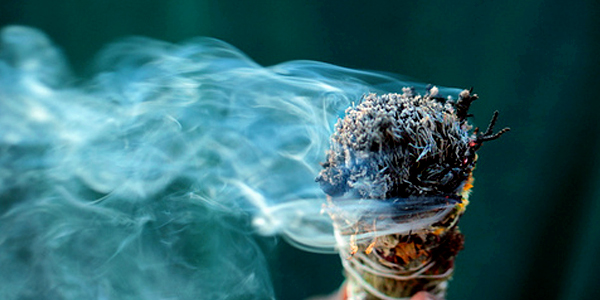
In the Visayas at the time of Spanish contact, there were five general categories of Visayan treatment of disease— massage, fumigating or sweating, prescription of medicine, countersorcery, and propitiation of supernatural beings. When speaking on treatments with smoke it was said Atolobwas, sweat induced by smoke, steam, or rubbing with hot stones or ashes, and was the most popular specific against skin diseases. Toob was to fumigate by covering the patient with mats and blankets to concentrate the smoke of medicinal fuels, and oslob was a steam bath in which the patient lay enclosed on a rack over containers of water into which hot stones were dropped. The woods used for this purpose were called bulung, meaning medicine—China wood (sarsaparilla), obat, was the most effective—from which was derived the terms burulngan or bulnganan for the little enclosed sheds.[1]
In modern times, Tu-ob is still a known ‘fumigation’ practice among some Visayan groups. On Panay Island, the Ma-aram (modern babaylan) usually performed this for babies at six o’clock in the evening to protect them from roving malevolent spirits. A baragahan, which is a small coconut shell containing ashes and embers, is sprinkled with a little native incense (kamangyan) to allow the emission of more smoke. The odor of the kamangyan is believed to drive the spirits away. Fumigation as a therapy is also performed to a mother right after her first bath a few days after child delivery. It is done right after the lubu-ob (the steam from a pot of boiled leaves to enter the mother’s body to prevent relapse from childbirth.) In performing fumigation, the mother wraps herself loosely in apatadyong (a barrel shaped-skirt extending down to the mid-ankle or longer) and lowers her body in a squatting position, allowing the fumes to envelop her body. Others prefer standing on a chair or a mortar and enclosing themselves with a buri (native palm) mat with the fumes from the baragahan going up their bodies via their two extended legs.[2]
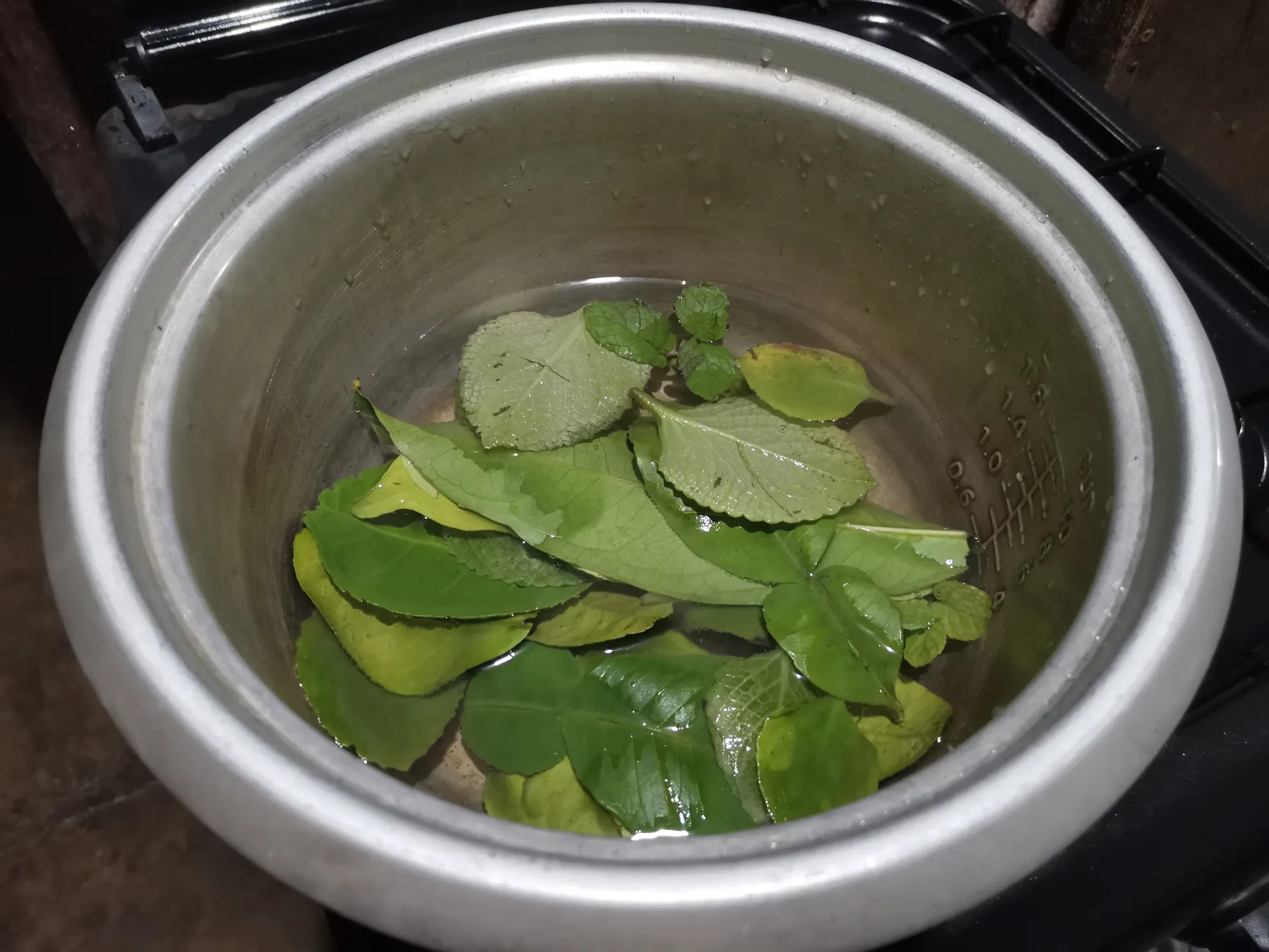
If you are in Bohol, there is a quick cleansing and protection ritual you can experience during the Abatan River Firefly Watching Tour. As you enter the grounds, a girl holds a clay pot with white smoke rising from it – likely incense. She encouraged my family and I to walk through the smoke as it was part of a ritual called “Palina” to make sure we were protected from bad spirits.
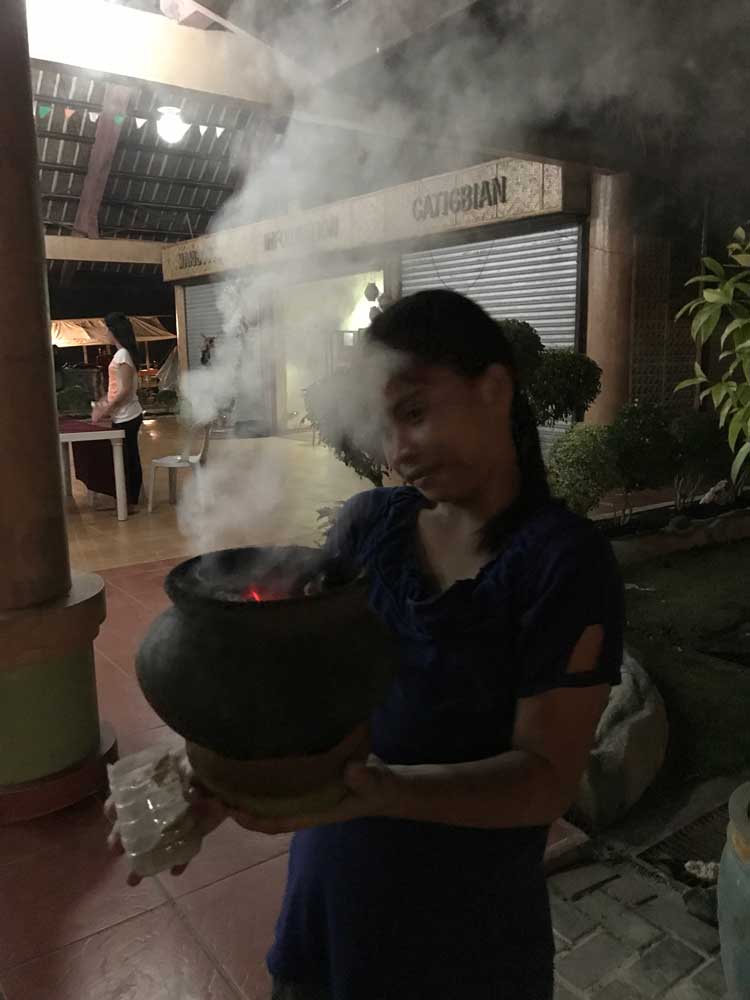
If you visit a Bisaya cemetery near All Saints and All Souls Day you will often find children performing the palina ritual for people exiting. For a few pesos you may walk through the smoke they create to cleanse yourself and ensure no spirits are following.
Similarly, in Bukidnon, Mindanao, after attending a funeral one must bring little things from the cemetery such as sticks and leaves, burn them, and smoke themselves. Expanding on this and differing a little , when a funeral is over and you are going home, at the gate you must spread your hands over the smoke of grass being burned and step over the fire. People believe that by doing so, the sorrow that the dead encountered will not happen to you. Another take says the smoke must be from the wreaths of condolence offered to the family.[3]
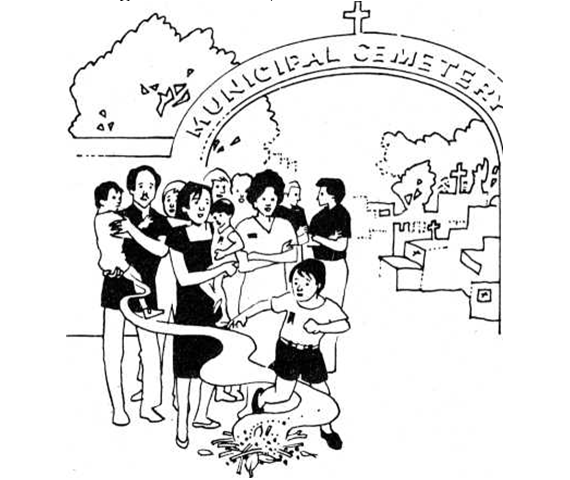
While Siquijor is known as the home of ‘witches’ in the Philippines, it is actually a place where healing traditions are said to have always featured prominently. The sight of a ritual being tagged as witchraft is somewhat understandable – not only for Siquijor, but also areas of Cebu. The whispered prayers in Latin and the other orasyon during a ceremony could be surprising. Further, in performing lengthy healing ceremonies, possession of the induced type (trance-possession) takes place. This is aided by meditation, prayer, chanting, inhaling of burning kamang- yan (resinous plant exudate) and the rhythmic and repetitive strumming or beating of musical instruments. In addition, drinking tuba (fermented coconut tree sap) and chewing betel nut seemed to contribute to a hallucinogenic effect on the ritualist who is already hypnotized by the long and repetitive sound of instruments. In this type of possession, the ritualist seems to undergo an altered state of consciousness.[4] In this case, smoke is used a delivery method through inhalation for the practitioner. I have read several online accounts of foreigners visiting Siquijor who were immediately put off when they were asked to inhale smoke during a healing ritual.
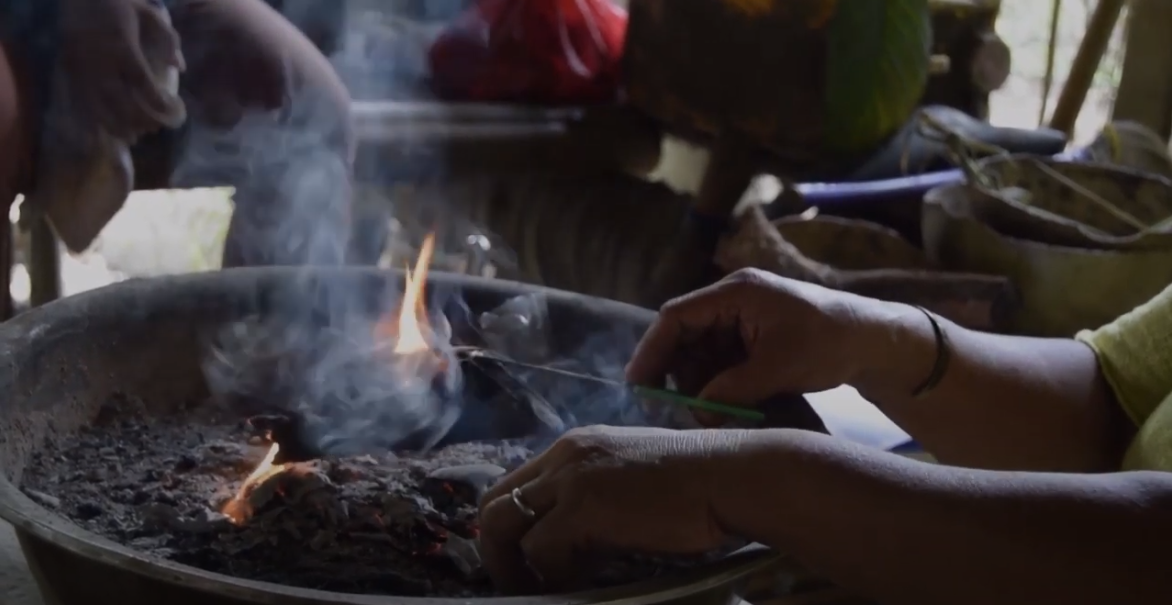
CREDIT: Fae Miranda
In Masbate, pausok is an herbolario’s way to diagnose a person’s disease by engulfing him in smoke.[5]
Kamanyang, oliva benditado, anahaw or nipa leaf, and dried banana leaves are burned in a coconut shell and the smoke is fanned toward the victim of maligno (harmful spirit). This is called tuhob. Tuhob drives the maligno away.[6]
Rituals are a component of the Bikolano cultural system. The baliana (priestess) recites prayers and incantations as she offers material things that would appease a displeased god or spirit. It can also be an act of thanksgiving. It is believed that the aroma of puto or linukay, or ibos makes the spirits healthy and happy, hence smoke is visible in every offering.[7]
In Cagayan de Oro, some believe burning dry leaves called tapas to fill the household with smoke will drive evil spirits away.
In Alang Alang, Leyte, the manloloon (he who performs the fumigation ceremony) burns in a coconut shell the memento stolen from a corpse. He starts the ceremony by reciting the creed, then with his cupped hands he spreads the smoke over or around the body of the patient who is seated on a chair. In the case of a baby who has had a fright, the manloloon picks him up and holds his body over the smoke while he says these words: (Ayaw na kahadlok, (ngaran hit taivo) kay line gin loloonan kana. Maalo ka na hit imo nahahadlokan kay gin loloonan ko na ikaw hit kaliyay panhiole, kilala, madbad, bokalas og tabog. Ayaw na kahadlok, ha, oo.) (Do not be afraid, (name of person), because you are now being fumigated. Be ashamed of your fear for I am now fumigating you with smoke from kalipay*, panhiole, kilala*, mad- bad, balokas, bokalas, and tabog* leaves. Do not be afraid anymore).[8]
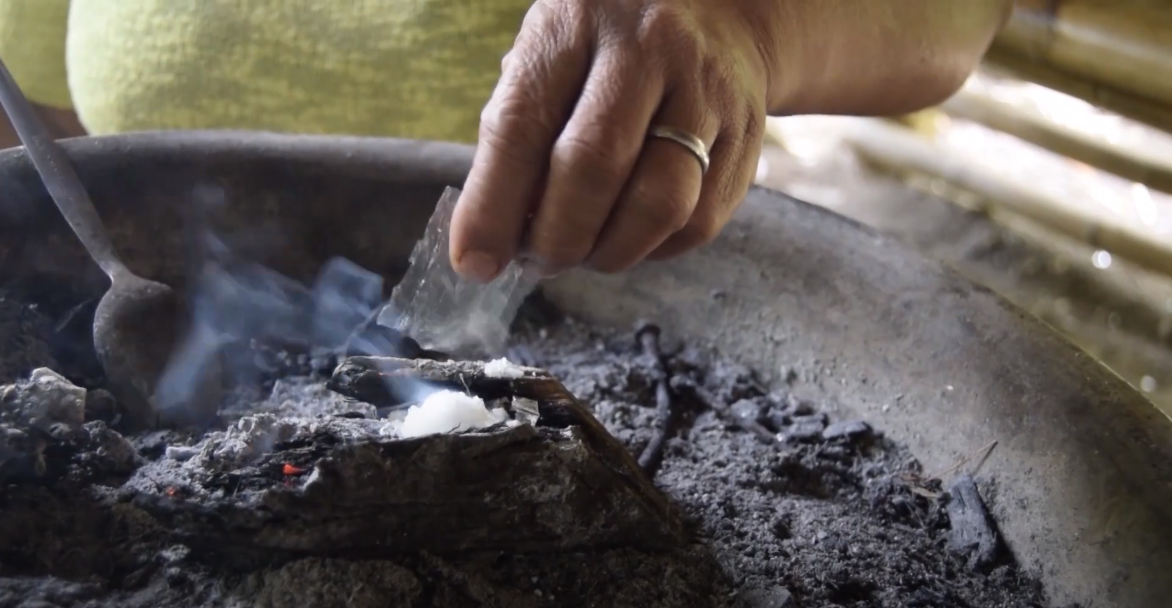
CREDIT: Fae Miranda
The Manobo of Agusan use smoke as a prenatal aid. The practice called ta-gi-á-mo_involves a piece of rattan being taken by one of the women present and, after being slightly burnt, extinguished by the midwife and held close to the person of the parturient. With her hands the midwife then wafts the smoke over the patient, reciting at the same time a formula.
Among the Tagalogs of Bay, Laguna hilots (healers) perform massage, sponge baths, and ‘smoking’ or ‘roasting’ are the principal aspects of postnatal care. This period is known as rimon or dimon. Three times within the rimon (or dimon), the mother undergoes the saklab, or roasting ritual. This consists of standing naked, except for a thick blanket wrapped around her body below the bosom, over live charcoal placed in a basin. Sweet-smelling insenso and leaves of medicinal plants are thrown into the fire in order to produce smoke. The main purpose of this practice is to hasten the healing of the uterus. The blanket is used to allow the smoke to heat the body of the mother. Care is taken not to heat the breast or else the milk will become rancid and the baby will have stomach trouble.[9]
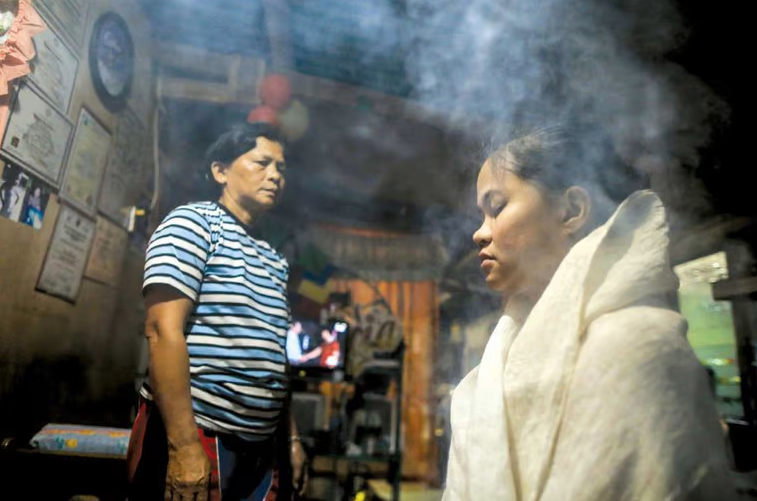
Soon after a birth, the Tinguians of Luzon wash the child, name it, and after being passed through the smoke of a fire the child is established in the home of its parents.
Smoke and incense is also used among many ethnolinguistic groups throughout the archipelago for “smudging” ritual items, hunting gear, fishing gear, and weapons. You will also find smoke being used before a harvest , although the particulars vary.
*Please note that this article is not intended to provide instructions for smoke cleansing.
SOURCES:
[1] Scott, William Henry. (1994). Barangay: Sixteenth-Century Philippine Culture and Society. Ateneo De Manila University Press
[2] Magos, Alicia P. (1992). The Enduring Ma-Aram Tradition: An Ethnography of a Kinaray-a Village in Antique. New Day Publishers
[3] Demetrio, Francisco R. (1991). Encyclopedia of Philippine Folk Beliefs and Customs. Xavier University
[4] Lieban, Richard W. (1967). Cebuano Sorcery: Maligh Magic in the Philippines. University of California Press
[5] Nasayao, Eden K. (2010). Bikol Beliefs and Folkways: A Showcase of Tradition. Hablong Dawani Publishing House
[6] Ibid
[7] Ibid
[8] Demetrio, Francisco R. (1991). Encyclopedia of Philippine Folk Beliefs and Customs. Xavier University
[9] Jocano, F. Landa. (1973). Folk Medicine in a Philippine Municipality. Punlad Research House
Jordan Clark is a Canadian born descendant of Scottish immigrants living on the homelands of the Lekwungen speaking peoples. His interest in Philippine myth and folklore began in 2004. Finding it difficult to track down resources on the topic, he founded The Aswang Project in 2006. Shortly after, he embarked on a 5 year journey, along with producing partner Cheryl Anne del Rosario, to make the 2011 feature length documentary THE ASWANG PHENOMENON – an exploration of the aswang myth and its effects on Philippine society. In 2015 he directed “The Creatures of Philippine Mythology” web-series, which features 3 folkloric beings from the Philippines – the TIKBALANG, KAPRE and BAKUNAWA. Episodes are available to watch on YouTube. Jordan recently oversaw the editing for the English language release of Ferdinand Blumentritt’s DICCIONARIO MITOLÓGICO DE FILIPINAS (Dictionary of Philippine Mythology) and is working on two more releases with fellow creators scheduled for release later this year. When his nose isn’t in a book, he spends time with his amazing Filipina wife of 20 years and their smart and wonderful teenaged daughter.


